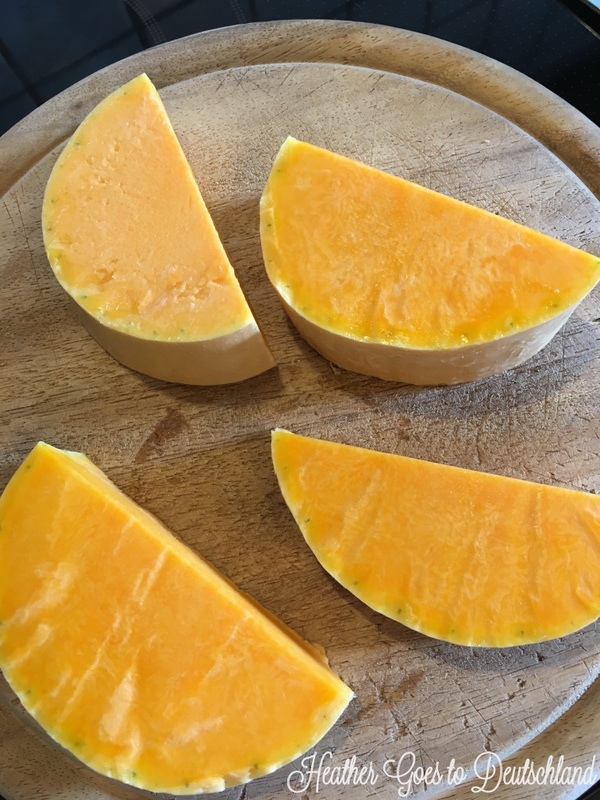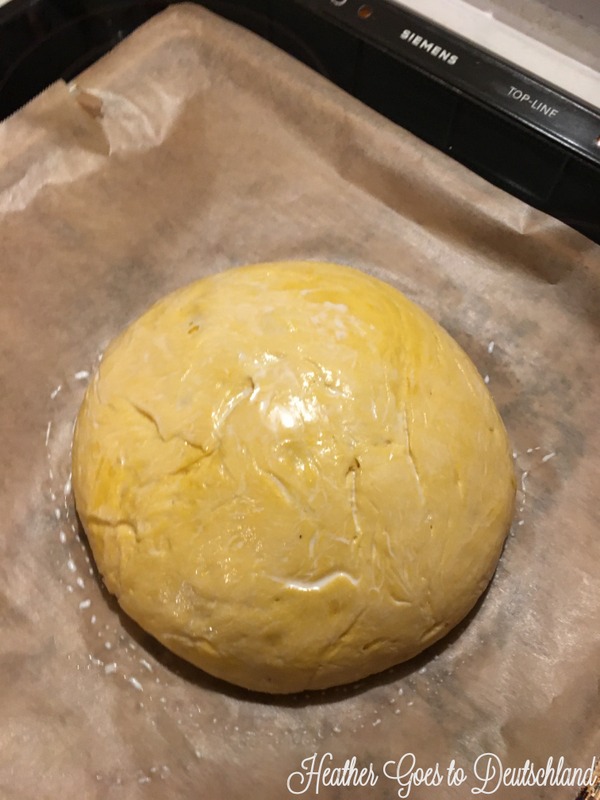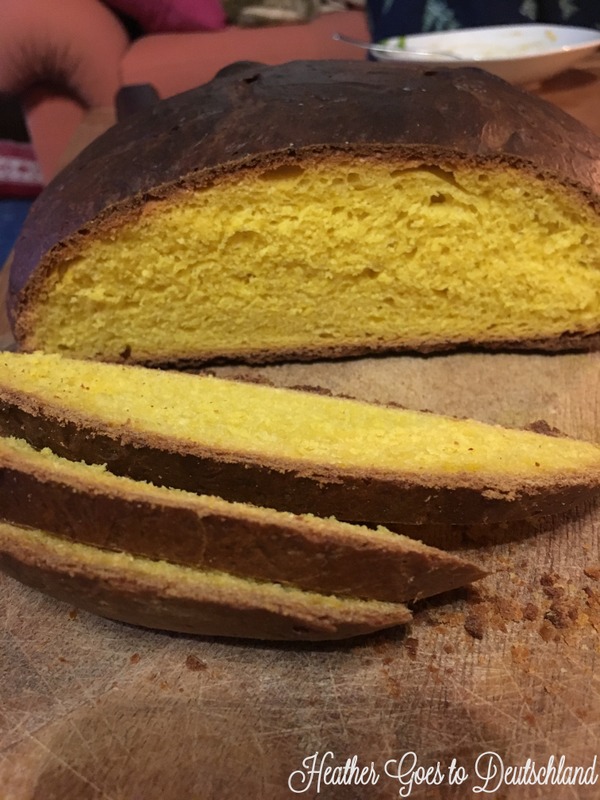The weekend of the Knerken was actually a double-bake weekend. The day before I made those, BV and I were invited to his dad for lunch, and BV had oh-so-kindly volunteered me to make a cake. Plus, on the Great British Bake Off, they did cakes in the second week so tie-in… score!
We had piles of apples around and so an apple cake was an easy choice. BV loves marzipan, so that narrowed it down from the handful of apple cake recipes in Classic German Baking… Apfel-Marzipan-Kuchen, or apple almond cake, it would be.
On Friday I went running around to gather the last of the supplies. On my list were almond paste and almond extract. According to the internet, and as I’d learned with my Rüblitorte, almond paste and marzipan were not the same thing. Turns out I should maaaybe read the ingredient notes so kindly provided by Luisa Weiss at the beginning of the book? She uses the term almond paste throughout the book to mean Marzipanrohmasse… it’s different to marzipan, but yeah… we already had that in the house. So that’s one thing down despite my unsuccessful shopping trip to find almond paste that didn’t exist.
And the almond extract? Despite checking the Karstadt food section (my Old Faithful when looking for various “exotic” ingredients such as vanilla extract), I came up empty. They did have some bitter almond Aroma, which seems to be like an almond essence in the U.S., so I grabbed that figuring something almond was better than nothing. Put a pin in that one.
Saturday morning I sprang into action. By which I meant I underestimated how long it would take to put this cake together and ended up flinging myself around the kitchen in a panic when it soon became evident that we would be late to lunch. No worries, BV called his dad and let him know. On the plus side, the wild boar was ready when we got there so no small talk preamble! On the negative side (depending on your opinion, haha), I didn’t do much of an Instastory on this one because laaaaaate.
Back to the cake. Step one… apples. Lots of apples.

The diced ones went into the cake eventually, while the slices ones waited to go on top. We’d had some random supermarket apples in the pantry for a touch too long, so those went first, followed up by a few small, tart ones from our garden. Next time I do this cake I would much prefer to use either A) all our own apples, of course, or B) some better, more tart apples. BV tends to buy the bag of apples that are practically flavorless to take to work. I don’t get it, but next time I’m grabbing some better fruit.
Next up was that marzipan, which needed to be grated. The 200 gram chunk grated up surprisingly easily at first, but that changed when I got to the last little bit of it. The stuff pretty much turned into a slippery ball in my hand, it was taking far too long and was far too sticky to deal with at that point, and I ended up just cutting it into small pieces as best I could and chucking it all in the bowl. If anyone has a better strategy than that, please drop me a comment!

Note the chunky bits on the bottom right.
It all banged together much more quickly from this point. The batter came together pretty quickly, but remember that almond Aroma? When then recipe called for a teaspoon of extract I grabbed the Aroma, which comes in these comically small little tubes. I attempted to shake one out into a teaspoon to measure it but much more of it went into the bowl (luckily) than the spoon. At that point I decided that measuring it was an exercise in futility, and since one tube was nowhere near a teaspoon, I’d just thrown in two tubes worth. I managed that, and then noticed that a bit had splashed onto my finger. So I licked it, naturally.
HOLY SHIT. NO. NO. NO.
SO MUCH BITTER ALMOND IN MY MOUTH OH GOD WHAT HAVE I DONE?
But you know what? It was already in the cake and we were late. It is what it is.
Thus, more apples went on top and into the oven it went.
While it was in the oven, BV and I put ourselves together and anxiously awaited the timer. I really thought I took a picture of it when it came out, in between us fanning it off in an attempt to cool the cake a whopping minute or two faster, but seems I didn’t. Never mind. Instead, please enjoy this picture of the cake, still in its form, on a wooden cutting board inside our cake caddy. On my lap, in our car, because we couldn’t trust it on a seat or the floor in case it slid and melted the dome. FUN!

This was a harrowing 20-minute drive to BV’s dad.
“No sudden stops!”
“Agh, it’s sliding!”
“Oh God, that’s warm!”
That one was when the condensation dripped on me, because I thought it would be a better idea to lift the lid slightly on the straight, flat highway in order to ventilate the thing a little. Debatable.
Eventually we arrived without incident, and the cake was placed on the windowsill to cool off while we ate, with the bonus feature of drawing in all the wasps that passed by! More fun!
Boar and Klöße* ingested, it was time to cut into the cake. Please enjoy this photo of half of the cake, upon its return to our house.

Photo doesn’t quite convey the journey this baby went through.

Texture shot.
There were five of us at this particular lunch, most of whom had just consumed a pile of roasted boar, two or three dumplings, cabbage, and salad. The fact that they still had room to eat half this cake is amazing to me, and I have a strict one dumpling rule. BV’s dad was particularly enthusiastic (he and BV’s mom split the sixth piece) about it. BV loved it. And me?

I may still have been tasting that bitter almond Aroma from earlier, but it was STRONG. I liked this cake quite a bit, but that flavor was a bit too strong and I have no idea if it was because of that almond essence, or just the crazy amount of marzipan that went into it. This cake is DEFINITELY not for someone who isn’t into marzipan, but luckily that’s not us.
The cake was really moist and flavorful, and the apricot glaze on top gives it a nice shine. I probably could’ve taken it out of the oven a few minutes earlier as it got a bit dark on top, but it didn’t hurt the taste too much.
As I mentioned before, next time I make this I’m going to look for some tarter apples and see about finding some real almond extract. I know I can get it online, but if anyone has seen it in a brick-and-mortar store in Germany, please let me know!
*dumplings





















